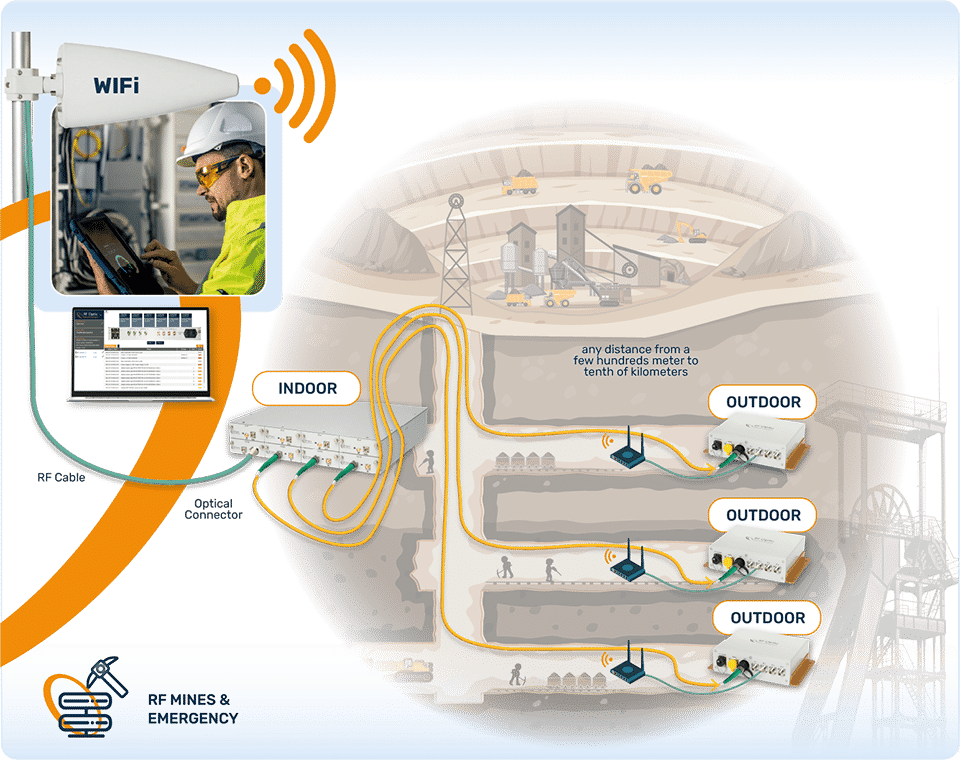
Mines & Emergency Services
Effective communication is crucial in the demanding mining environment. However, traditional two-way radio networks often suffer from signal degradation, limited coverage, and high maintenance costs. This application note explores how implementing an RF over Fiber system revolutionized communication at a customer mine site.
Why use RF over Fiber and not coax?
Before the RF over Fiber system, the mine relied on a two-way radio network that struggled with frequent signal losses, especially in remote or underground areas. Maintenance costs were high due to the need for antenna adjustments, cable replacements, and unreliable signal amplification equipment. RF over Fiber technology overcomes these challenges by::
- Mitigate signal degradation replacing coaxial cable losses with RFoF link gain.
- Add access points to overcome terrain features that caused coverage gaps and communication dead-zones.
- Expand coverage in previously unserved critical areas.
- Reduce maintenance and upgrades which led to increased operational expenses.
- Improve reliability and improve communication quality which impacted safety and operational coordination..
Key characteristics for mines & emergency services
Generally, underground mining operations utilize RF over Fiber (RFoF) technologies to facilitate reliable communication between the surface controls and underground units replacing traditional cable or digital systems. This approach allows miners to maximize the available transmission bandwidth with reduced noise and ensured better linearity. An RF over Fiber link is a robust communication solution. It comprises a Transmitter unit (Tx) that transforms the analog RF input signal into an optically modulated signal and a Receiver unit (Rx) that converts the optical signal back into an electrical RF signal. The optical modulation typically operates at wavelengths of 1310nm for links below 10GHz or at 1550nm for most higher frequency links. Some specific applications may use multiple other optical wavelengths and may be multiplexed onto a single fiber. The optical signal travels from the Tx module to the Rx module over single-mode optical fibers, ensuring efficient and high-quality signal transmission vital for safety and effective communication in the challenging underground environments.
Frequency range & RF coverage
The RF over Fiber system must cover frequencies from 0.1GHz to 2.5GHz to ensure seamless VHF and UHF communication. In some cases, a full coverage of the WIFI 2.4GHz and 5.8GHz bands is also desirable.
Application & Design
An RFoF system was installed in a mine site as a replacement of a legacy coaxial cable system. key components of that RF over Fiber system include:
- Optical Transceivers: Installed at strategic points across the mine site, these devices convert RF signals to optical signals for transmission and reception.
- Optical Fiber Cables: High-quality armored optical fiber cables were laid out to carry the optical signals, ensuring minimal signal loss over long distances.
- Optical Splitters and Amplifiers: These components maintain signal strength and distribute signals to various areas of the mine site.
- Monitoring and Control System: A centralized monitoring system allows for real-time monitoring of signal strength, quality, and system performance.
Benefits
- Improved Communication: The RF over Fiber system significantly improves communication reliability and coverage. Personnel could now communicate seamlessly even in previously problematic areas.
- Enhanced Safety: Reliable communication enhances safety protocols, enabling quick response to emergencies and improved coordination during daily operations.
- Lower Maintenance Costs: The system’s robust design and reduced signal degradation minimizes the need for frequent maintenance, leading to cost savings.
- Operational Efficiency: With reliable communication channels established, operational efficiency increases as personnel could collaborate effectively, leading to smoother workflows and reduced downtime.
- Scalability: The modular nature of the RF over Fiber system allows for easy scalability as the mine site expanded or new communication needs arose.
System Configuration (Example)
The system comprises an indoor unit in the upper part of the mine connected to the antenna through coax cables. 3 fibers SMF are running to the lower floors and are outdoor. Lan connection is set up. By this the system overcomes problems of coverage and signal degradation for safety and communication usage.
Monitoring & Control
RFOptic’s solutions come equipped with an independent graphical user interface (GUI) displaying both optical and RF levels in real-time. This monitoring capability aids broadcast teams in adjusting settings on the go, ensuring optimal performance during live events.
Deployment
the installation of the single-mode fiber infrastructure. This streamlined deployment minimizes setup time, allowing broadcast teams to prepare quickly and efficiently for live events, while ensuring extensive coverage without the limitations of coaxial cables.
Conclusion
RFOptic’s optical RF broadcast solutions represent a significant advancement for broadcast companies seeking reliable, high-quality audio and video transmission during live events. With the ability to extend operational ranges, reduce maintenance costs, and simplify deployment, RFoF technology is the ideal solution for enhancing broadcast capabilities.
Contact Us









